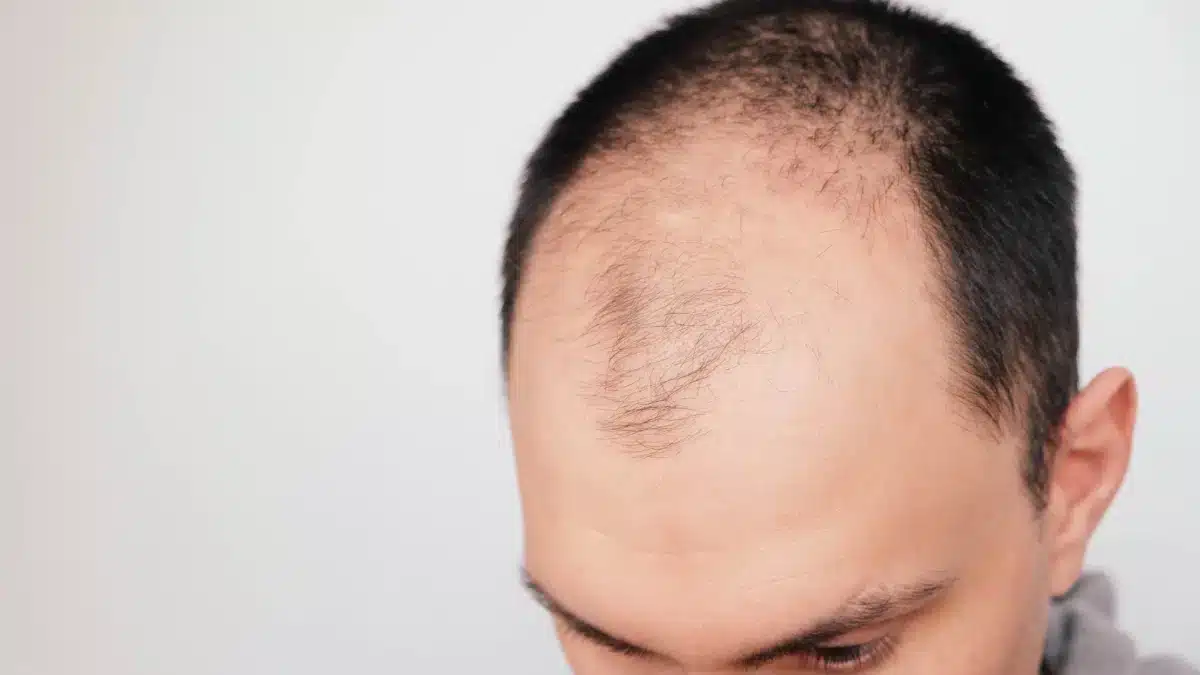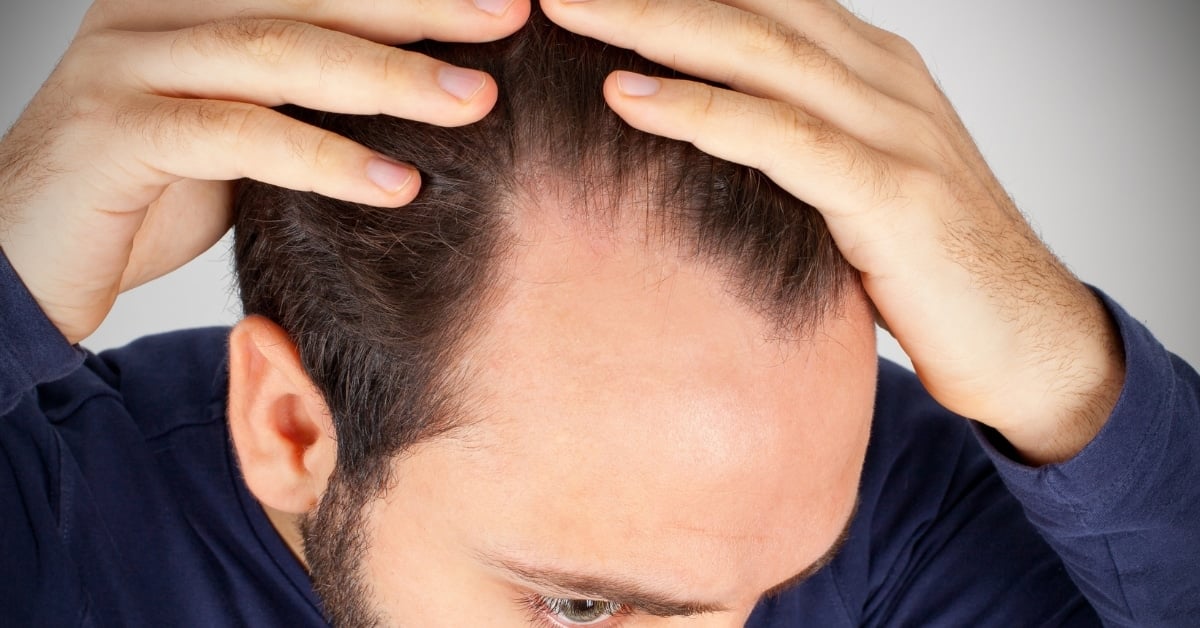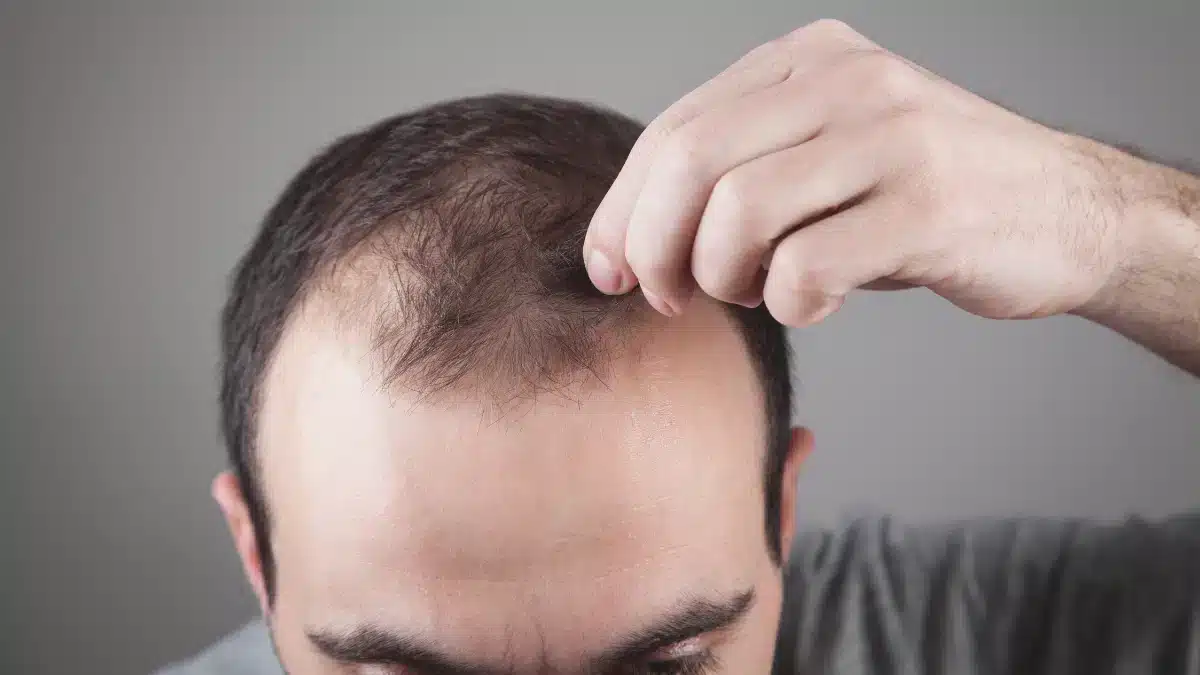Male Pattern Baldness – Everything You Need to Know
Androgenetic Alopecia is a medical condition in which individuals lose their hair.
This condition is called Male Pattern Baldness and is the most common type of hair loss in men.
The shredding of hair takes place in a definite pattern; it either begins from the front end or the back.
The U.S. National Library of Medicine (NLM) found that 50% of males over 50 will have this hair loss disorder.
Here, we walk you through the stages, causes, early signs, and risk factors of Male Pattern Baldness.
Here, you will also get the treatment options to tackle every stage of hair loss.
Stages of Male Pattern Baldness
According to the Hamilton-Norwood scale, there are seven stages of male pattern baldness.

Stage 1
Here you will hardly notice any hair loss or hairline recession.
Stage 2
There’s slight hair loss near the temple region (the skin between your ears and forehead).
Stage 3
Here you may experience deep hairline recession around your temples. Your hairline may have a “U” or “M” shape.
Stage 4
You have a profound hairline recession and hair loss at the crown part (top of your head).
Stage 5
Your hairline recession gets in connection with the bald spot on your crown.
Stage 6
The hair present between your temples and crown is thinning or has gone.
Stage 7
Here you have a barren patch on your head and a thin band of hair around the sideways.
Signs and symptoms of male pattern baldness
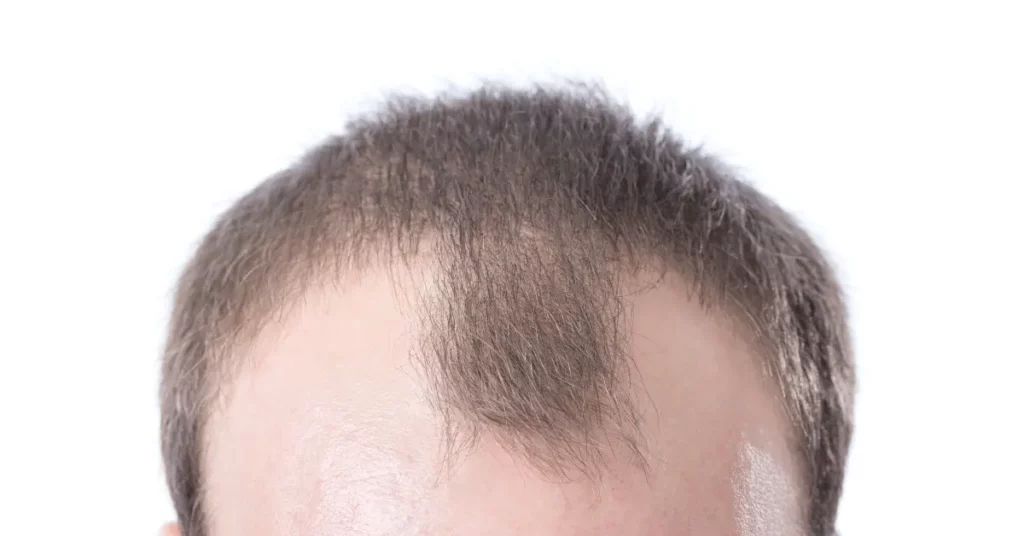
The symptoms might differ depending on the cause of hair loss.
There is no specific pattern for hair loss; you can experience it within a matter of time, or it may affect your scalp.
Signs and symptoms of hair loss include,
Gradual thinning on top of the head
It is the most common type of hair loss, affecting individuals as they age.
In men, the hairline begins to withdraw from the forehead.
Circular or patchy bald spots
Some people lose hair in patchy or circular bald spots on the eyebrows, beard, or scalp.
Before the hair falls out, you may experience itchy or painful skin.
Sudden loosening of hair
Hair loss could either be due to physical or emotional shock.
You may shred a handful of hair when washing, combing, or even after gentle tugging.
This type of hair fall usually causes temporary hair thinning.
Full-body hair loss
Specific medical treatments, like chemotherapy for cancer, can result in hair loss throughout the body.
In most cases, the hair grows back.
Scaling patches that spread over the scalp
This condition indicates the presence of ringworm.
It usually shows symptoms of swelling of the scalp, redness, broken hair, at times, oozing.
What causes Male Pattern Baldness
Androgens, particularly Dihydrotestosterone, and genetics contribute to Male Pattern Baldness.
DHT, derived from Testosterone, plays a considerable role during puberty.
It helps in regulating body hair growth, sexual development of males, and deepening your voice.
“People sensitive to DHT hormone may find their hair follicles shrinking and becoming less efficient.”
Arran Isherwood
In individuals genetically predisposed to this condition, DHT binds to hair follicles in certain areas of the scalp, making them sensitive to its effects.
This interaction triggers miniaturization, causing affected follicles to produce progressively thinner and shorter hairs, shortening the growth cycle.
Consequently, hair density decreases as more follicles are affected, resulting in a noticeable pattern of hair loss, typically starting at the temples and crown.
The following reasons can trigger DHT to cause hair loss,
Family history (Heredity)
The most significant factor in Male Pattern Baldness is genetics.
You are more likely to develop this condition if you have a family history of baldness, particularly on your mother’s or father’s side.
Specific genes, such as those related to the hormone DHT sensitivity, play a role in determining your susceptibility to hair loss.
Hormonal changes and medical conditions
Hormonal factors, particularly DHT, are implicated in Male Pattern Baldness.
DHT is derived from Testosterone, which can attach to hair follicles, resulting in them to shrink and produce thinner, shorter hairs.
Over time, this leads to a gradual reduction in hair density.
Medications and supplements
Some medications, such as certain blood pressure drugs, anabolic steroids, and chemotherapy drugs, can lead to hair loss as a side effect.
Medical conditions like thyroid disorders and autoimmune diseases can also contribute to hair thinning.
Stress
Stress can exacerbate the condition and hair loss in individuals who are genetically predisposed to it.
High stress levels can disrupt the hair growth cycle.
Hairstyles and treatments
Excessive use of hair styling products or accessories can cause Traction alopecia.
Traction alopecia is a medical condition caused by repeated hair pulling.
Hot-oil hair treatments and permanents might cause hair fall.
Risk factors
Several triggers can increase your risk of hair loss, those include
- Age
- Stress
- Poor nutrition
- Significant weight loss
- A family history of balding from either parent’s side
- Specific medical conditions, such as Diabetes and Lupus
When do men start losing hair?
If you find out that your hair is thinning, draw some comfort by adding that you are not alone.
Male pattern baldness affects most of the male population at some stage.
According to the American Hair Loss Association
- 1/4th of males with hereditary male pattern baldness lose their hair before they hit the 21 brackets
- By 35, approximately 3/4th of the male population will have experienced some degree of hair loss
- Approximately 85 percent of men will have thinner hair by the time they reach 50
When to see a doctor?
If you are worried about your hairline thinning, consult with your doctor.
Your doctor will suggest possible treatments, remedies, and alternatives.
Remember, prevention is always better than cure.
Talk to your doctor as early as possible so they can suggest early treatment.
Immediately inform your doctor if you notice sudden or patchy hair loss.
Sudden hair loss might be an active signal of an underlying medical condition.
Treatment

The treatment of Male Pattern Baldness can differ and depends on the severity of hair loss and individual preferences.
Following are some of the common treatment options:
Medications
Doctors commonly prescribe the following FDA-approved medication to decrease hair fall.
Finasteride is a prescription oral medication that inhibits the production of DHT, the hormone responsible for hair follicle miniaturization.
It can help slow hair loss and promote regrowth.
Another commonly prescribed medicine is Minoxidil, which stimulates hair follicles and can slow hair loss or promote regrowth.
Low-Level Laser Therapy (LLLT)
LLLT devices use lasers or LEDs to stimulate hair follicles and improve hair growth.
They are available in various forms, including combs, helmets, and caps.
Platelet-Rich Plasma (PRP) Therapy
PRP involves drawing a small amount of blood.
It processes and concentrates the platelets and injecting the PRP into the scalp.
It can stimulate hair follicles and promote hair growth.
Hair Transplantation
Surgical procedures like follicular unit transplantation (FUT) and follicular unit extraction (FUE) involve transplanting hair follicles from donor areas to balding areas of the scalp.
Prevention
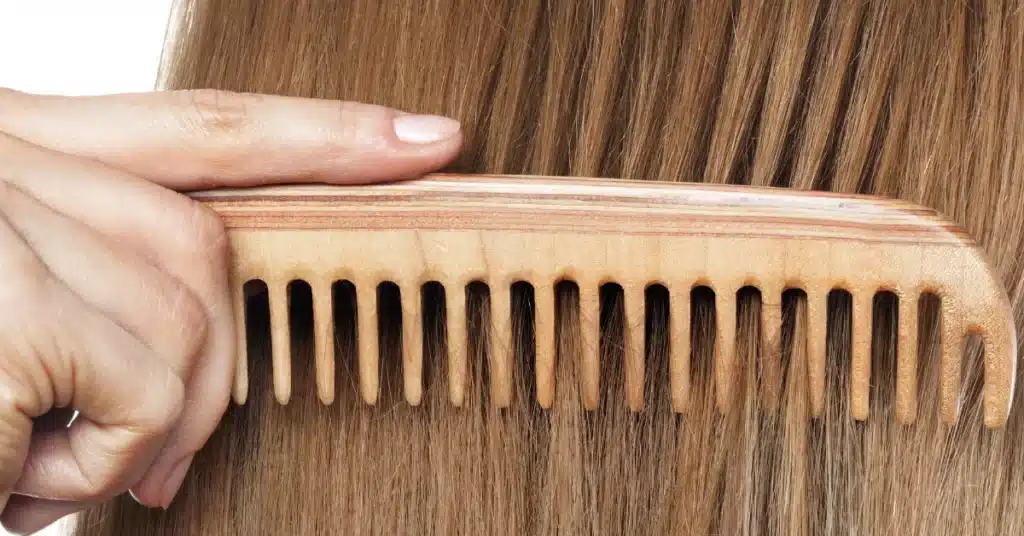
The hair loss disorder is mainly caused due to genetics and can not prevent this type of hair loss.
These tips may help you avoid early signs of hair loss
- Be gentle with your hair
- When your hair is wet, and you are trying to brush or comb, use a detangler and avoid tugging
- Prefer using a wide-toothed comb
- Avoid harsh cosmetic treatments like hot oil treatments, curling irons, hot rollers, and permanent
- Try to limit the use of hairbands, braids, barrettes, and rubber bands
- Reveal your medical history and supplements before the doctor to know the possible interactions
- Avoid staying long hours under direct sunlight and other sources of UV light
- Avoid smoking as it might be a cause of baldness
Conclusion
Male Pattern Baldness is a common and often genetically predetermined condition that affects many men as they age.
While its causes are multifaceted, understanding the role of genetics, hormones, and environmental factors, especially DHT, can shed light on its development.
Various treatment options are available, ranging from topical medications to surgical procedures, offering hope and potential solutions to those seeking to address this condition.
Ultimately, knowledge and early intervention can pave the way to a confident and empowered approach to managing Male Pattern Baldness.
Frequently Asked Questions
What causes male pattern baldness?
Genes are one of the major causes of male pattern baldness. Other possible factors include hormonal changes, medical conditions, stressful events, or hairstyle treatments.
Is Male Pattern Baldness Alopecia?
Yes, Alopecia is a common form of hair loss in both genders. In men, this condition is called male-pattern baldness. Hair is lost in a well-defined pattern above both temples (the skin between your ears and forehead).
Does Male Pattern baldness come from the mother?
No, Male Pattern Baldness doesn’t need to come from the mother. It is a popular myth that hair loss in women is passed down from the mother’s side, and hair loss in men is passed down from the mother’s side. But the truth is that the genes responsible for hair loss are passed down from both sides of the family.
How common is Male Pattern Baldness?
Male Pattern Baldness is highly common. By age 50, around 50% of men experience some degree of it. Genetics primarily determine susceptibility, making it a prevalent condition among men.
Is Male Pattern Baldness X-linked dominant?
No, Male pattern baldness is not X-linked dominant. Pattern baldness is a sex-linked recessive trait. It is carried on the X chromosome.
WowRx uses only high-quality sources while writing our articles. Please read our content information policy to know more about how we keep our content reliable and trustworthy.
